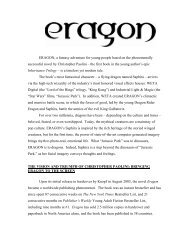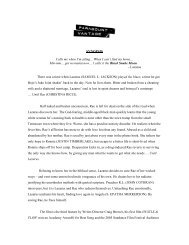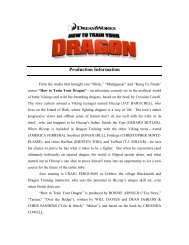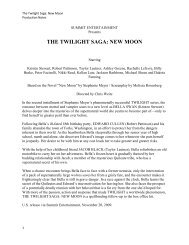FOX SEARCHLIGHT PICTURES PRESENTS An ... - Thecia
FOX SEARCHLIGHT PICTURES PRESENTS An ... - Thecia
FOX SEARCHLIGHT PICTURES PRESENTS An ... - Thecia
Create successful ePaper yourself
Turn your PDF publications into a flip-book with our unique Google optimized e-Paper software.
BEES: SPECIAL FACTS ABOUT THEIR SECRET LIVES<br />
There are nearly 20,000 species of bees in nine recognized families, though many are not<br />
catalogued and the actual number is probably higher. [1]<br />
The smallest bee is the dwarf bee at 2.1mm. The largest is the Megachile Pluto at 39mm. [2]<br />
Honeybees live in hives or colonies. A small hive contains about 20,000 bees, while some larger<br />
hives may have over 100,000 bees. Hives include one queen, hundreds of drones, and thousands<br />
of worker bees. [3]<br />
The worker bees are female, but they do not breed. The queen bee is female and creates all the<br />
babies for the hive. The drone bees are male and do not have stingers. [4]<br />
Bees communicate with each other about food sources using dances. The sounds from the<br />
movement of the bees are picked up by the tiny hairs on the bee's head. Bees without stingers<br />
communicate only by sounds. [4]<br />
Bees use the sun as a compass orienting the dance angle to the plane of polarization of the<br />
sunlight. [5]<br />
The honeybee has been adopted by at least sixteen states as the state insect. [6]<br />
The honeybee's hive has cells made of wax. This is where the queen bee lays her eggs. She can<br />
lay 2000 eggs in one day during spring and 1000-1500 during foraging season. [7]<br />
Bees could travel as many as 55,000 miles and visit more than 2 million flowers to gather enough<br />
nectar to make just one pound of honey. [8]<br />
Most bees gather only pollen or nectar. As she sucks the nectar from the flower, it is stored in her<br />
second stomach ready to be transferred to the honey-making bees in the hive. If hungry she opens<br />
a valve in the nectar "sac" and a portion of the payload passes through to her own stomach to be<br />
converted to energy for her own needs. [9]<br />
When her nectar "sacs" are full, the honeybee returns to the hive. Nectar is delivered to one of the<br />
indoor bees and is then passed mouth-to-mouth from bee to bee until its moisture content is<br />
reduced from about 70% to 20%. This changes the nectar into honey. [9]<br />
The bee is a marvelous flying machine. She can carry a payload of nectar or pollen close to her<br />
own weight. [8]<br />
When a bee stings, the stinger, poison sac and several others parts of the bee's anatomy are torn<br />
from the bee's body. It soon dies. [10]<br />
14

















